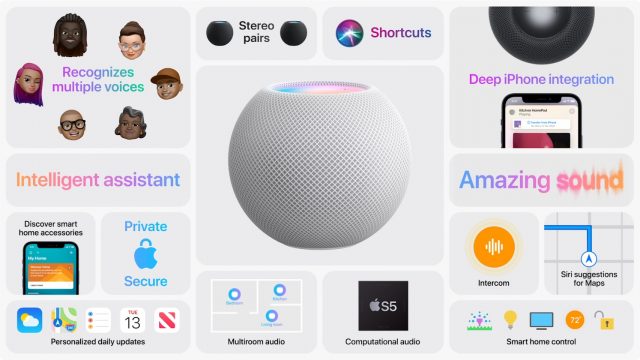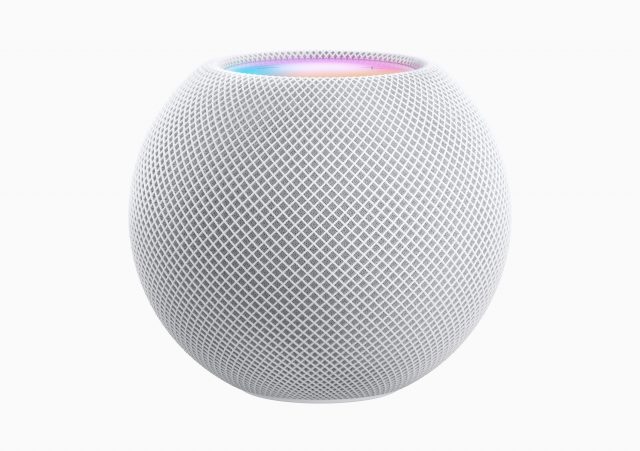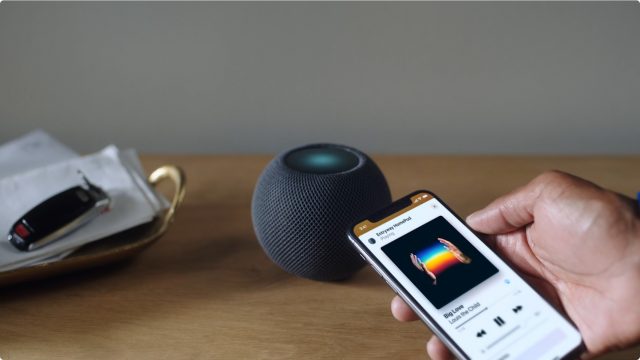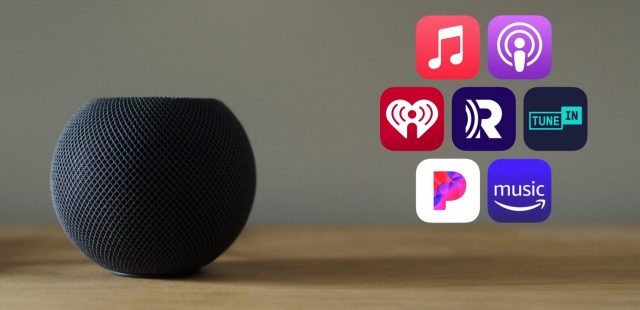Apple Introduces $99 HomePod mini
As Amazon and Google have steadily broadened and augmented their smart speaker lines in recent years, Apple’s competing HomePod has remained stagnant. The smart speaker was released nearly two years ago and has been shown little public love since, with the original $349 price dropping to $299, and a typical street price now hovering around $199.
Apple has, at last, expanded its HomePod line. At the company’s “Hi, Speed” event, Apple led off with the $99 HomePod mini, which is essentially just a smaller, cheaper HomePod.
The new speaker stands just 3.3 inches (8.4 cm) tall and 3.9 inches (9.9 cm) wide, compared to the original HomePod’s 6.8-inch (17.2 cm) height and 5.6-inch (14.2 cm) width. It’s wrapped in a similar mesh fabric in white or space gray.
Unlike the cylindrical HomePod, the HomePod mini has more of a spherical shape, albeit with a flattened top where you’ll find familiar touch controls and Siri waveform color animations. Coincidentally, Amazon also recently went spherical with the fourth generations of its Echo and Echo Dot speakers.
The HomePod mini incorporates an S5 chip that uses “computational audio” to process and adjust sound 180 times per second. (Apple also uses the S5 in the Apple Watch Series 5 and Apple Watch SE.)
The HomePod mini also benefits from a U1 chip that enables a short-range radio technology called Ultra Wideband. (The HomePod lacks such a chip.) The U1 appears to be the key ingredient in an upcoming change to the haptic feedback you get on an iPhone when handing off audio to or from a HomePod mini. The handoff feature isn’t new, but visual, audible, and haptic effects during a handoff will be—assuming this happens with a newer, U1-equipped iPhone, such as the iPhone 11 and iPhone 12 models. In addition, personalized listening suggestions and user controls will appear on an iPhone when it’s near a HomePod; this feature also requires the U1 on both devices. Apple said a future software update would enable these features.
The original HomePod retains some advantages over the HomePod mini. It’s bound to have better sound, based on its hardware specs. Apple says the HomePod mini has a “full-range driver and dual passive radiators” while the HomePod packs a “high-excursion woofer and (an) array of seven tweeters.”
Like the HomePod, the HomePod mini can be combined in a stereo pair (and even used as stereo speakers for a TV), but it appears that you can’t pair a HomePod with a HomePod mini in this way.
The HomePod has a couple of features the HomePod mini lacks. These include “spatial awareness,” a capability that lets the HomePod judge a room’s characteristics relative to its position and adjust its audio accordingly. Also, the HomePod has a “home theater with Apple TV 4K” capability. As Jim Dalrymple explains:
A new feature is coming … only for the HomePod that will add an immersive home theater experience when paired with an Apple TV 4K. To get the 5.1, 7.1 surround, and Dolby Atmos, you need to pair one or two HomePod speakers to the Apple TV. This feature requires the spatial sound support of HomePod, so it isn’t available for the HomePod mini.
Apple announced a new feature for both HomePod speakers and other Apple devices: Intercom. This capability, mimicking ones long offered by Amazon and Google speakers, allows users with multiple HomePod devices to communicate across a residence—one speaker to one speaker, or one speaker to multiples. Intercom should prove useful for announcing to a household that dinner is served, for instance. You can send also Intercom messages to an iPhone, iPad, Apple Watch, and even a CarPlay-equipped vehicle.
On the audio-service front, and also not unique to the HomePod mini, Apple will soon provide support for additional third-party music services, including Pandora and Amazon Music—but, glaringly, not Spotify. (Spotify and Apple are still having a bit of a tiff.)
For a bit of context, the HomePod line is still audio-only while Apple’s competitors have been offering “smart display” products with screens and videoconferencing cameras for a while now. Siri also is a bit of a laggard in many ways compared to Amazon Alexa and Google Assistant.
The HomePod line does have tight Apple integration going for it. For instance, Siri works with HomeKit-compatible home automation devices. And with a more enticing $99 price tag, the HomePod mini is bound to be a hit with those who are invested in the Apple ecosystem, even if entry-level smart speakers from other vendors cost less. We’re curious to see how the HomePod mini’s sound quality will compare to the original HomePod, which is excellent.
You can pre-order the HomePod mini starting on 6 November 2020, with the product shipping beginning the week of 16 November 2020.




The HomePod launched in the US at $349, and was reduced to $299 in April 2019. It was never $399 in the United States.
Thanks, fixed. Working very quickly and late here.
No worries! Appreciate your dedication!!
Kinda confused. The current HomePods and all my phones (including an iPhone 7 with no U1 chip) have haptic feedback during handoff.
Honestly, we’re not really sure what the difference is either—Apple spun through that very quickly.
I just went back and listened to this section of the talk, and Apple’s saying that later this year, the U1 chip will be used to enhance the existing handoff experience. Scroll to about 6:20 in.
A reader pointed out that the HomePod mini has only 802.11n instead of the 802.11ac with MIMO that the HomePod has. @glennf did a little research and found that the FCC filing for the HomePod shows that it supports both 2.4 GHz and 5 GHz, which suggests that the HomePod mini could drop back from the hundred of Mbps in 5 GHz to the 54 Mbps of 802.11g in 2.4 GHz.
In theory, that should still be enough bandwidth, but the increased latency and reduced throughput might put limitations on creating stereo pairs of the HomePod mini. I was also thinking that the difference in Wi-Fi support might also explain why you can’t create a stereo pair of a HomePod and a HomePod mini.
The other interesting thing I learned is that the HomePod mini supports a new Internet of Things networking protocol called Thread. This is the first I’ve heard of it, but it sounds like it might be part of the Apple/Google/Amazon Connected Home over IP collaboration.
Thread has been around for a few years, although it has recently become popular as a possible IoT protocol. It competes against several other short-distance networking protocols including Bluetooth, Zigbee and Z-Wave, all of which are short-range, non-Internet protocols (sometimes featuring mesh capabilities for extended range.)
Thread is built over 6LoWPAN, which is IPv6 running over low-power wireless “personal area networks”. A personal-area network is one with a very short range, typically used for communication between devices worn on or installed in a human body (e.g. a smart watch, a headset, a glucose monitor, a pacemaker, etc.)
In the case of 6LoWPAN, the PAN used is IEEE 802.15.4, which is used as the basis for several other similar technologies including Zigbee.
There has been a lot of work in the domain of short-range networking, including devices we don’t normally consider networked, like garage door openers. With IoT becoming more popular and problems with putting Wi-Fi everywhere (including cost, power consumption, size and security), it’s not surprising that all of the major IoT players are now looking at these “PAN” networking technologies.
Will there be a big shake-out that makes Thread the dominant player over the rest? Will Bluetooth Mesh win? Will Zigbee suddenly become popular? It’s anybody’s guess right now.
Was it mentioned that the Homepod and Homepod mini can exist together? I know adding a 2nd Homepod can make it stereo but what about a Homepod + Homepod mini? Why hasn’t Apple made more than just two colors? Why not brown? tan/beige? or fun colors for kids/teens?
Not sure about you, but that entire Hi Speed felt like an infomercial. Very good production values/camera work but just marketing…Apple. (I wouldn’t give my 12 year-old a $600 phone to record shredding/skateboarding videos…instead - here, take this $200 GoPro…can do much more and not damage/lose an expensive smartphone–right?)
Free tip: wait for BestBuy sale on Homepods…usually $100 less than Applestore. I got a pair for $199 each instead of the $299 retail at Apple.
I haven’t read anything about this yet, but I don’t think it would be desirable. The two devices are going to sound different (which is better is a discussion I’ll leave to others). If you would pair them together, you’ll start noticing things like “gee, the left speaker has more bass response than the right”.
This is the same reason why, when assembling a stereo system, you always match the left and right speakers. You might be OK with a mismatched center-channel speaker or mismatched front-rear speakers, but you never want mismatched left-right speakers.
I don’t know how you would feel about that, but it would really bother me.
I have read that HomePod and HomePod mini cannot make a stereo pair.
Yep, in our article.
Thanks all! I dunno how I missed that line in your article, Adam!
I was thinking it would be neat to have a 3channel setup like two Mini’s (L/R) and the HomePod as the rear (sub). But then for that cost, one can get a decent Vizio soundbar with bluetooth (along with satellites and sub) with change to spare.
Ah, I read the loop article and it looks like TWO Homepods with 4K AppleTV will do some kinda Home Theater with Dolby Atmos in future update. Still, $300 to $600 is more than a non-Siri Speaker bar setup (5.1). Guess its up to your needs.
Amazing how Apple spent almost no time discussing how a Pair of original HomePods in a main entertainment room would integrate into a gaggle of HomePod minis scattered around a house. No U1 WideBand chip in the original, but after a bit of finagling I was able to have Siri find my watch by speaking to my HomePod original. From the comparison sheet on Apple’s website it looks as though the original HomePods will be able to participate in the Intercom feature, and THAT may become the signature feature of the device, driving families to give up on the embedded, vehicle manufacturer specific infotainment centers in their cars so long as one uses CarPlay when driving about.
My Audi SUV can display gorgeous Google Earth maps as I’m driving, but the driving instructions and video clues from iOS are superior and more user-friendly. If I’m 45 miles away and my spouse can remind me that we really need that one signature enhancing ingredient for the dinner we’re making for guests, that will be AWESOME (assuming, of course, that I’ve not just picked up our dinner guest and she casually mentions that the dinner has to be just perfect because he’s SUCH a jerk!
I’m staying with my Bose 100s, 301s, and Acoustimass 7!
Intercom? Did someone say Intercom? That’s a nice feature if only I could find it somewhere. Guidance please?
Hi, it’s the U.K. calling. It’s all about Spotify here so
Plus can I Airplay from any app to this? Plex? Roon? If not then it’s not really a competitor to other WiFi speaker options.
The Intercom feature was mentioned in the presentation. It starts at 10:15 in the Youtube video.
It’s also on the HomePod mini’s web page. Scroll down a bit to find the description:
Thanks. So Siri and carPlay are the entry points to this feature?
And Apple has just released Intercom for the large HomePod devices:
We covered the new release here. Still need to do more testing with Intercom.
This Macrumours article has a good description of the new Intercom feature:
A couple of take-aways…
IPhones and iPads won’t work until iOS 14.2 is released
It won’t work if the Homepods are a stereo pair
Jason Snell has posted a review of the HomePod mini.
Our (well, mostly Tonya’s) experience so far is that it just works like our larger HomePods and sounds great.